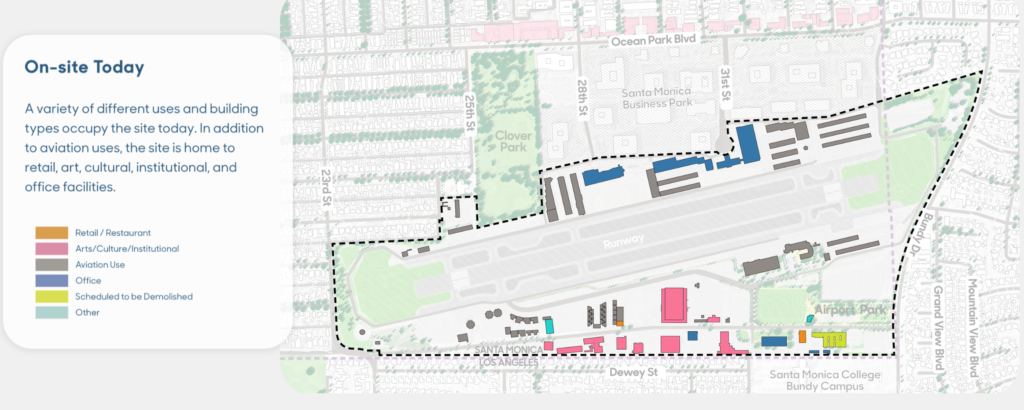Image via the Let Your Voice Be Heard flyer handed out before the Airport Conversion Project meetings by supporters of the Great Innovation Park concept. You can download or read a pdf of the flyer, here.
In the leadup to the kickoff of the public process on the future land uses for what is now the Santa Monica Airport, a new vision for the land was presented by a group of futurists who call their vision “The Great Innovation Park.” Their vision includes plentiful open space, a STEAM innovation and education center, and “a beautiful multimodal sustainable transportation hub.” The transportation hub would help pay for the creation and upkeep of the open space and innovation center and would feature a version of Archer Aviation’s “air taxis” that could be coming to Santa Monica Airport as early as 2025.
To be clear, the pitch for this proposal is not “let’s keep the airport open,” but more “let’s turn Santa Monica airport into the transit hub of the future.” The Innovation Park proposal is built around the idea of air taxis that are affordable for anyone much the way rideshare is now. Details of how much this proposal could raise or the exact amount of space required aren’t available just yet, but supporters are working to make sure such a proposal is considered and examined before the city makes any decisions.
“I want this place to become the pride of Santa Monica,” said Ben Marcus, a Santa Monica resident and one the the leaders behind the Innovation Park concept. “I want it to be a place where thousands of people come every single day, to learn, to recreate and to be productive in their work.”
Both the concept of allowing the electric airplanes, even quiet electric ones that don’t require a runway to takeoff and land and the contract with Archer Aviation have proven controversial in advocacy circles. The initial announcement of the 2025 service was met with howls of protest online from advocates frustrated that the city would entertain new contracts so close to the date it can officially close the airport.
“This is not what we voted for,” was a common refrain at the time, referencing Measure LC, which was passed by Santa Monica voters and restricts what the city can do with airport land should the city close the airport. The language of the measure does not restrict the continual operation of the airport; but when it was debated and passed by voters in 2014 it was widely assumed that the city would close the airport if it could.
But for Marcus and the Innovation Park team, whether or not the airport should be completely closed is still an open question; and the city is missing out on potential opportunities by looking at whether or not the airport should remain open or be closed.
“I don’t think that this needs to be a question of ‘airport or no airport.’ I think that sort of like binary choice is a bit misguided,” continued Marcus. “Forcing the community into that choice leaves us in a difficult situation at the end of 2028, because if the airport shuts down it’s very unlikely that a park would be built right away.”
Under a consent decree with the federal government, the city can close Santa Monica Airport on January 1, 2029. But 2028 is a critical one for Santa Monica and the region for a different reason. It’s the year the Olympics will come to greater Los Angeles. Forty years after the 1984 Olympics, things have changed and traffic congestion has gotten worse. Marcus and the Innovation Park team believe that the air jet taxis could be at least a partial solution to the traffic nightmare in the Olympics and beyond.
So instead of “keep the airport open” or “close the airport,” Marcus sees a different question, should the city plan for a grant-and-taxpayer funded great park now, or should they plan for a transportation hub that can be worked on now and have money ready to begin park construction on January 1, 2029.

But every plan for the park has tradeoffs. Critics of the Innovation Park proposal point out that under current law, even if the electronic airplanes don’t require a runway to takeoff or land they would still need to maintain a runway. Measuring 3,500 feet long and 150 feet wide, the runway takes up roughly ⅓ of the space that would be available for open space development.
But Marchus points out that yes, a runway would be needed and of course there would be land required to actually house the fleet of electronic airplanes, but that there would be some flexibility as to how large it has to be. The city has already been allowed to shorten the runway after the consent decree with the federal government. The size of a runway post-2028 depends on how many planes the city decides it needs to create a truly affordable service.
“(A small runway) would only serve a very small portion of the population if we only had one small vertical takeoff and landing location, you could only get 100 or 200 people a day. And so that remains sort of an elite service,” Marcus explains.
“If we want to make this part of our public transit system in Santa Monica and move thousands of people each day by air instead of in cars, we’ll need more space.”
